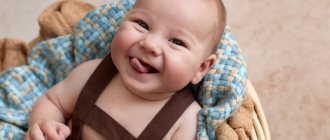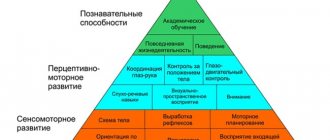What is this age characterized by?
The child begins to actively listen and observe. He already knows mom and dad well, walks happily and smiles when he sees them, and becomes quiet if a stranger enters the room. He not only knows his parents, but also recognizes familiar voices. Sounds are the new information that becomes available at this age. A revival complex is observed - the child’s reaction to the mother’s approach (walking, moving arms and legs, general activity), which is considered the most important indicator of normal mental development. Children at this age are very cheerful. Each new item brings a smile and a desire to explore, look, listen. At the appointment, the pediatrician will provide the necessary information regarding the growth and development of the baby, tell you how much children should weigh at 2 months, and whether there is a need for feeding with artificial formulas.
What to do with your child?
All parents want the best for their child: for him to be smart, healthy, and physically developed. All in your hands! Use your child's active interest in his surroundings.
Developmental mat
The baby does not benefit from constantly lying in a crib; from the end of 5-6 weeks he can already be placed in a playpen or on a development mat. The surface here is not as soft as in a crib, this promotes active movements. Hang one or two bright toys in the child’s field of vision (at a height of 30-40 cm) so that he learns to focus his gaze and subsequently tries to grab them with his hands.
Toys need to be replaced with new ones from time to time. It is better that they have a sound - like rattles or bells, then the baby will quickly understand that it is he who makes this sound when he hits the toy with his hand. This way he will be aware of his own activity, the position of his body in space, and make purposeful movements with his hands.
Ilya’s mother, 5 months: “We got our favorite toy when we were just over 2 months old. They say that kids like everything yellow and red—bright, that is. And we had a gray smiling rattle hippopotamus with big eyes in which the pupils moved. Ilyusha, if you showed him this rattle, immediately smiled and pulled his hands towards it. I think it was because the hippo's face looked like a smiling face."
If you have a mobile phone, turn it on from time to time while you are awake. 5-10 minutes is enough, otherwise the child will get tired.
Expanding the boundaries
Hold the baby vertically in your arms; this will train the muscles of the neck and back, which allow you to hold the head, as well as the vestibular apparatus. Move around the room like this, approach the window so that the baby can see the bright sunlight. He will look at new objects and hear new sounds.
Physical development
The baby constantly moves his arms and legs, learns to unclench his fists, grab his mother’s fingers, and the sides of the crib.
To develop the grasping reflex, place various objects in your baby’s hands, smooth and hard, soft and fluffy, rustling and ringing. The neck muscles are gradually getting stronger, the child is already able to hold his head up for about 20 seconds. His skills are growing every day, it’s amazing how much he can learn in such a short time. Muscle tone improves and movements become more coordinated. The height and weight of a newborn at 2 months are the most important indicators of the baby’s development, which is why pediatricians pay so much attention to this.
Sensory development
At home, there are many opportunities for a baby’s sensory development. The period of wakefulness in the second month of life lasts approximately 40-60 minutes. You can accomplish a lot during this time. Feeding usually occurs first, followed by a period of activity, after which the tired baby falls asleep.
Tactile perception
The baby is actively exploring the world, and tactile sensations are a rich source of information for him. Tactile contact with mother is very important for a baby. A crying baby will calm down when the mother simply holds him in her arms. Gentle strokes on the back and head relax the baby and help you get ready for sleep. More active and faster movements, on the contrary, activate the baby. Always change your baby very gently and gently. Try not to cause discomfort during hygiene procedures.
Do not swaddle your baby while he is awake to allow his arms and legs to bounce. Let him be naked - arrange air baths (at a temperature of 22 ° C). First for 1-2 minutes, gradually increasing the duration by a few seconds. Air baths are also a hardening procedure.
Elements of massage
Place your thumb in your baby's palm - he will grab it tightly. Stroke his palm and fingers, the back of his hand, straightening his fist.
After bathing, apply baby oil to your back and buttocks using gentle movements. If you put the baby on his side and move him along the spine, he will bend and straighten his back.
Stroke his tummy in a circular motion (at least half an hour should pass after eating) - this helps with colic and develops the oblique abdominal muscles.
With your baby lying on his back, use your thumbs to stroke his feet up and down and in a spiral, and then stroke the outside of his legs from bottom to top. The entire massage lasts no more than five minutes.
Vision
Tracking a toy is one of the effective techniques for developing the visual analyzer. Just pick up a bright toy, maybe one that sounds, and move it slowly from left to right, from top to bottom and diagonally. This needs to be done slowly. Get your baby's attention by talking to him gently. All classes for 2-month-old children last no more than 5 minutes; the baby cannot concentrate on one thing for longer.
Toys for children 2 months old should be bright, fairly large in size and simply arranged, without unnecessary details. Of course, they should be made from the safest materials - as soon as the baby learns to hold the toy, the next step will be the ability to bring it to the mouth.
Hearing
Auditory concentration, which occurs in the first weeks of life, is the basis for the development of the ability to distinguish sounds, and then speech. At two months, the baby flinches from sharp sounds and smiles when he hears his mother’s voice.
Call the baby, who is in the arms of another adult, out of his field of vision. The baby will try to turn around at your voice. This also works with other attractive sounds, such as the noise of a favorite rattle. He listens if you sing him a song.
Music is an important element in the development of a child at 2 months.
The baby does not know how to concentrate for a long time, but will be happy to listen to a lullaby before bed. For 5-10 minutes, he will listen to the soft and gentle sounds of the melody that you play for him. Buy a collection of classical music adapted for babies. It will be useful to you throughout the first year; over time, your baby will begin to recognize his favorite sounds.
Vika, mother of 4-month-old Arseny: “Having read about the benefits of classical music, I began to play Sene Mozart from the age of 2 months. His reaction was amazing! He froze and listened carefully. He was not afraid, but on the contrary, he was very interested. Now he already has his favorite works, for example the C major Sonata Rondo-Andante and the C major Sonata Rondo-Allegro. And the Turkish March, of course.”
Normal child growth
Height at birth is considered the initial indicator on which further calculations are based. Based on it, a conclusion is drawn about development in the prenatal period. Both very high and low indicators are alarming. In the first three months of life, a child gains 3-3.5 centimeters in height, that is, during this period he can stretch by 10.5 cm. An increase in height, like weight gain at 2 months, is strictly monitored, and the general trend shows how well the development is going.
For convenience, special centile tables have been created. Finding the ratio of age and weight in them, the doctor receives a number from 1 to 7. This is a simple scale, where 1 is very short, and 7 is too tall. In fact, only these two numbers are worth paying attention to; all the rest are within normal limits. Extreme indicators occur infrequently, only in 3% of babies.
Baby's weight
The question of how much children should weigh at 2 months, as well as in all subsequent months, worries all parents without exception, even if the baby is no different from the average peers. Children who are too thin or plump cause even more anxiety. Don't forget that every child is individual, and everyone develops differently.
The average weight of a newborn is 2.6-4.5 kg. In the first week of life, a decrease in weight usually occurs (acceptable loss of up to 10%), this is due to the loss of fluid and the release of primary feces - meconium, which was formed during intrauterine development.
During the first month of life, the baby becomes heavier by leaps and bounds, the set is up to 20 g per day. In the second month, this figure increases and is already 30 g per day.
The normal weight at 2 months is calculated taking into account how the child was born. To this figure should be added 750 g for each month lived (valid only up to three months of age). The weight gain in 2 months is 1.5 kg.
Hearing
What should a 2.5 month old child be able to do? The baby must not only carefully observe the world around him, but also hear all the sounds. This is very easy to check: just look to see if he turns his head in the direction in which the loud sound was just heard. Bells, rattles and other sounding toys promote the active development of the auditory organs. Avoid toys with loud sounds, and when communicating, make sure your voice is calm and not too loud.
If the indicators differ from the statistical average
About 15% of children have slight deviations from the average table indicators.
This is not a problem and does not require correction. In the process of growth and development, all indicators will return to normal in accordance with the genetic characteristics of the body. When a child turns 2 months old, height, weight and head circumference may differ from standard indicators, but must be harmonious in relation to each other. Doctors are more concerned if the child is very small or thin, or the opposite situation, when there is excess body weight. In this case, the reason for such deviations should be found out. This may be an unbalanced diet (lack or excess), serious diseases of the gastrointestinal tract, hormonal changes, genetic diseases, infections, congenital malformations.
The examination will help determine the cause, and an experienced doctor will prescribe comprehensive treatment.
Educational games for a 2.5 month old baby
It is not necessary to shower a child who is 2.5 months old with expensive gifts, because in your home there will be many things that will be of interest to him. For example, you can sew several fabric toys, filling them with buckwheat, small balls or straw. Holding them in your hands, the baby will develop fine motor skills.
In addition, you can arrange small musical concerts for your baby, during which you will sing, dance and play small musical instruments. We are sure that the baby will watch what is happening with interest!
And, of course, do not forget to introduce your child to household items. Show and tell him about paintings, dishes, clothes, toys. At the same time, try to choose items with bright colors and interesting textures.
Photo: depositphotos
How will your child grow up?
All these indicators are important so that doctors can monitor the baby's development, but they do not tell how your baby will grow up.
Everyone probably remembers their school days, when the smallest of the boys turned into tall (and after military service, broad-shouldered) guys by graduation. There is a formula by which you can calculate the approximate height of a child. To do this, you need to add the height of both parents in centimeters and divide the result by two. If you have a boy, then you need to add 5 centimeters to the result obtained, and if you have a girl, then subtract the same amount. Do not forget that you are the closest, but not the only relatives of the child, and genes can convey any information taken from the depths of your family tree.
Child development. New opportunities, new prospects - baby 2-3 months old
Choosing toys
- To stimulate motor activity, the baby will need a large, bright toy; it would be good if it also had sound. The “classic” version of such a toy is the tumbler
. - At this age, children can spend a long time looking at bright towels, colorful scarves, etc. attached to the side of the crib or the wall of the playpen. (and in the future, turn your whole body towards them and try to grab them). You can attach a special “developmental” mat
: such mats with hanging mirrors, toys, ribbons, “squeakers”, etc. are sold in children's goods stores. Some models of such rugs are designed to grow and can be transformed as the baby’s abilities and interests change, so your child will be able to play with them when he gets older. However, we must remember that the rug, scarf or towel must be securely attached to the side of the crib or playpen so that the baby does not get entangled in them. - Particular attention will have to be paid to the choice of rattles
, because now your baby will not only look at them, but also hold them in his hand, so a rattle for a 2.5 - 3 month old child should have a comfortable handle. It is best if it has the shape of a straight rod with a rounded end. It is good if the rattle is made of a material that is soft and warm to the touch: according to experts, it is such materials that stimulate cognitive activity, while toys that are hard and cold to the touch frighten babies. And finally, there should be no doubt about the harmlessness of the material from which the toy is made. - “Research material” for a child can be not only toys, but also household items
: offer him (but only under the supervision of an adult!) a painted wooden spoon with a rounded handle, a pom-pom made of thread, a whisk for whipping. - To diversify a child’s tactile sensations, you can sew toys or (if you don’t have time) bags from bright fabric, filling them with “fillings” that feel different to the touch: washed river sand, peas, feathers, straw, etc. Ready-made toys are now available for sale of such kind. For example, a soft cube, all sides of which are sewn from different materials (satin, fur, terry cloth, etc.), or a cow stuffed with plastic balls. You can stuff ready-made soft toys with this material. It is better if the bags or toys are small and oblong in shape - then it will be more convenient for the baby to hold them in his hand. It is also necessary to ensure that the fabric from which they are made does not fade, is dense and durable, and that the seams are well sealed - after all, the first thing a little researcher will do is try to taste the “research objects”. It is desirable that the fabric from which different bags or toys will be sewn be different in texture. You can simply offer your child scraps of fabric of different colors and textures, no more than 20 cm long (the edges need to be trimmed).
Previously, in Russian villages, rattles were made from “environmentally friendly,” durable and “warm” materials: wood, birch bark, bast, bone (sometimes the same bone horns from which babies were fed were used as rattles, putting peas in them and sealing the hole) . Even such unusual materials as pet bladders and dried bird necks were used. Such toys were difficult to break, and the baby could taste them without harm. In addition, small children were often given ordinary household items to play with and “study”: “bread” spoons, bast shoes, wooden Easter eggs, boxes - and not only because they had few specially made toys, but also in order to the baby became familiar with the world in which he was to live as early as possible. |
Learning to control your body
- Around 4 months, the baby begins to learn to turn on his side on his own. To help your baby, place a tumbler in the crib or playpen next to the baby lying on his back. The same role as the tumbler can be played by a bright scarf, rug, or simply a large piece of patterned fabric hung on the side of the crib or the wall of the playpen. Babies are especially attracted to fabrics with contrasting patterns.
- Try to set a more “distant” goal for your child: place the toy at a distance so that it is not so easy to reach it. In this case, the child will also want to reach it and will first turn to it, and then reach out and even try to crawl. After several such attempts, move the toy towards the child.
- When showing your baby a toy, walk around the crib or playpen with it so that the child turns around, following the toy with his eyes.
- Tie a bell on a ribbon to the baby's arm or leg or attach a special rattle with Velcro - this will not only give the baby great pleasure, but will also help him learn to feel his body. There are also “musical socks” on sale, in which a small rattle is inserted, but a similar thing can be made independently by firmly sewing bells to ordinary socks.
Developing fine motor skills
Grasping objects and holding them in your hand is by no means an easy task for a two- to three-month-old baby. To help your baby learn this, offer him a new version of the game with a rattle. 1
(instead of a rattle, you can use a painted wooden spoon with a rounded handle):
- Show the child a rattle, rattle it, move it from side to side; when the baby reaches out his hand to the toy, help him: place the rattle in his palm. If the child at first cannot hold the rattle and immediately drops it, pick it up and give it to him again. The game will become more interesting for the baby if you offer him rattles each time, different in color and shape (but do not forget that they must have a handle that is easy to grip.)
- When the baby learns to hold a rattle in his hand for a sufficiently long time, complicate the game by changing the shape of the object being grasped: put the baby on his stomach, and in front of him place a small (but in no case less than 3 cm in diameter!) bright round object (this can be, for example, a ring from a pyramid or a figurine from a plastic Lego constructor designed for the little ones). When the child grabs it and tries to bring it to his mouth, take the ring from him and put it in front of him again. Then replace the small ring with a larger ring. This game will help your baby learn to grasp objects of different sizes in his hand.
- Continue to complicate the game by offering your baby two rings at the same time - a large one and a small one. In the future, introduce objects of a different shape into the game, placing in front of the baby blocks from the same “Lego” with large parts, soft toys or bags with “fillings” that feel different to the touch (see their description above), etc. Thanks to this game, not only motor skills develop, but also touch.
Invite your child to take toys from different positions: lying on his back, sitting in the arms of an adult, etc. Try giving him two toys at the same time.
The tumbler appeared in Russia not so long ago - less than 200 years ago. Historians believe that it came to us from Japan. The prototype of this toy was the hermit monk Dharma (the Japanese called him Daruma) who lived in the 6th century AD, who brought the teachings of Zen Buddhism and tea from his native India to China and Japan. According to legend, Daruma devoted himself to prayer and meditation for nine years, as a result of which he came to enlightenment. All this time he sat facing the wall of his cave, without moving or even blinking. From sitting for a long time, the monk’s arms and legs withered, so the Japanese tumbler, which is called “daruma,” has no arms and legs. She is dressed in traditional red robes for Buddhist clergy (remember the traditional red outfit of our tumblers!). Daruma is usually made from wood or papier-mâché. In Japan, daruma is taken very seriously. It is believed that this toy brings good luck to people who are persistent in achieving their goals. On New Year's Day, every Japanese buys a daruma figurine that has no eyes on its face. You are supposed to draw one eye on the daruma and at the same time make a wish. If the wish comes true, then the owner of the daruma “rewards” him with a second eye, and if not, the daruma remains with one eye until the next New Year, after which it is burned during a special ceremony. The first Russian wooden tumblers, which appeared at fairs in the early 19th century, were called “somersaults”; At first it was merchants, clowns and girls on the ball. |
Learning to listen and speak
It is believed that learning to perceive the rhythm and timbre of sound helps the baby master speech. Therefore, small “musical activities” not only bring pleasure to the child, but also contribute to his development.
- Let your child listen to a recording of the same melody performed on different musical instruments (if you yourself studied music, you can perform the melody yourself - for example, on a harmonica, a children's pipe, a metallophone). You can hum a melody that your baby heard performed instrumentally. It should be borne in mind that the melody should be simple, easy to remember and its range should not exceed one octave.
- Take your baby in your arms and dance with him to the music. Try doing gymnastics to music.
At 3-4 months, your child begins to “talk” not just like that, but purposefully: with his “speech” he wants to attract your attention. Try to make your communication more fruitful.
- Teach your child to imitate your speech. To do this, first repeat his “favorite” sound several times yourself (by listening carefully to his “monologues”, you can easily identify it). After a while, the baby will begin to repeat this sound after you. Then introduce new sounds into the “roll call” (preferably vowels at first). Thanks to such “dialogues,” the baby’s articulation skills will improve.
- When talking to a child, even the smallest one who seemingly “doesn’t understand anything,” never lisp or distort words.
- When you feed and dress your child or play with him, try to talk to him not about extraneous topics, but about what you are doing at the moment. At the same time, repeat the so-called “key” or main words more often: the names of parts of the child’s body and items of clothing, dishes and toys. In this case, it will be easier for the baby to remember the sound and meaning of these words.
1 Games with rattles for children 1 and 2 months old, see my articles “Child Development. Games and toys: month one”, No. 9/2001 and “Child development. Games and toys: month two", No. 10/2001. |
Let's sum it up
When we talk about how much children should weigh at 2 months, we mean an average value that will not be universal for absolutely everyone. If a newborn baby weighed 3 kilograms, then his weight at 2 months should be within 4.5 kg. A difference of 0.5 kg is considered insignificant. Also take into account past illnesses of both mother and child (if breastfeeding is practiced). These factors can lead to a decrease in weight gain, but during the recovery period everything should return to normal. The constitution of the parents and the height of the child must also be taken into account; it is difficult to expect that a tall two-month-old baby from large parents will weigh like a feather.
How to establish a daily routine
The schedule is drawn up for the baby individually, taking into account his characteristics. For convenience, you can start from the time when the baby wakes up in the morning.
Below is an approximate regimen for a 2-month-old child, but when creating your own, you should take into account some of the nuances of feeding. The baby may wake up during the night and demand to be fed, in which case you should not ignore it. There is also nothing wrong with periodically putting your baby to bed or feeding him 15-20 minutes earlier or later than the planned time.
Breastfed
If a two-month-old baby is fully breastfed, his typical daily routine might be:
06:00-07:30 – Feeding, diaper changing, washing and other hygiene procedures as necessary
07:30-09:30 – Bedtime
09:30-11:00 – Classes with laying on the stomach, second feeding
11:00-13:00 – Time for a walk and sleep in the fresh air (if the weather does not allow, we sleep at home)
13:00-14:00 – Feeding (the child gets full on average in 15-20 minutes)
14:00-16:00 – Sleep time
16:00-17:00 – Feeding and educational games (possible during a walk)
17:00-19:00 – Bedtime
19:00-20:30 – Feeding, hygiene procedures
20:30-23:00 – Sleep time
23:00-00:00 – Feeding
00:00-06:00 – Night sleep
When breastfeeding, it is completely normal to give your baby access to the breast on demand. But this does not mean at all that it is impossible to plan a child’s routine at 2-3 months - the baby needs food every 3 hours during the day and every 4 hours at night. These standards apply to most babies; there is no need to worry if your baby's timing is slightly different. The main thing is that he receives the daily milk intake - about 900 ml with a single serving of no more than 130 ml.
For an artificial baby
If the child is bottle-fed, the regimen should be designed taking into account the fact that formula takes longer to digest than breast milk. A 2-month-old baby needs to be fed every 4 hours, and sometimes a little less often.
For example, the timing of feeding the mixture is: 06:00, 10:00, 14:00, 18:00, 22:00 and 02:00. Otherwise, the daily schedule of a two-month-old artificial baby is no different from the schedule of breastfed children. How much baby should eat at one feeding depends on the type of formula used, follow the instructions on the package.
Mixed feeding
All adjustments to the daily routine of a 2-month-old baby are made largely by nutrition. Upon request, the baby is applied to the breast and the formula is given afterward if the baby cries or is not satisfied. Monitor the amount of milk you drink by weighing yourself before and after feeding to understand how much formula you need to give.
In this case, the time intervals between feedings will be from 3 to 4 hours.








